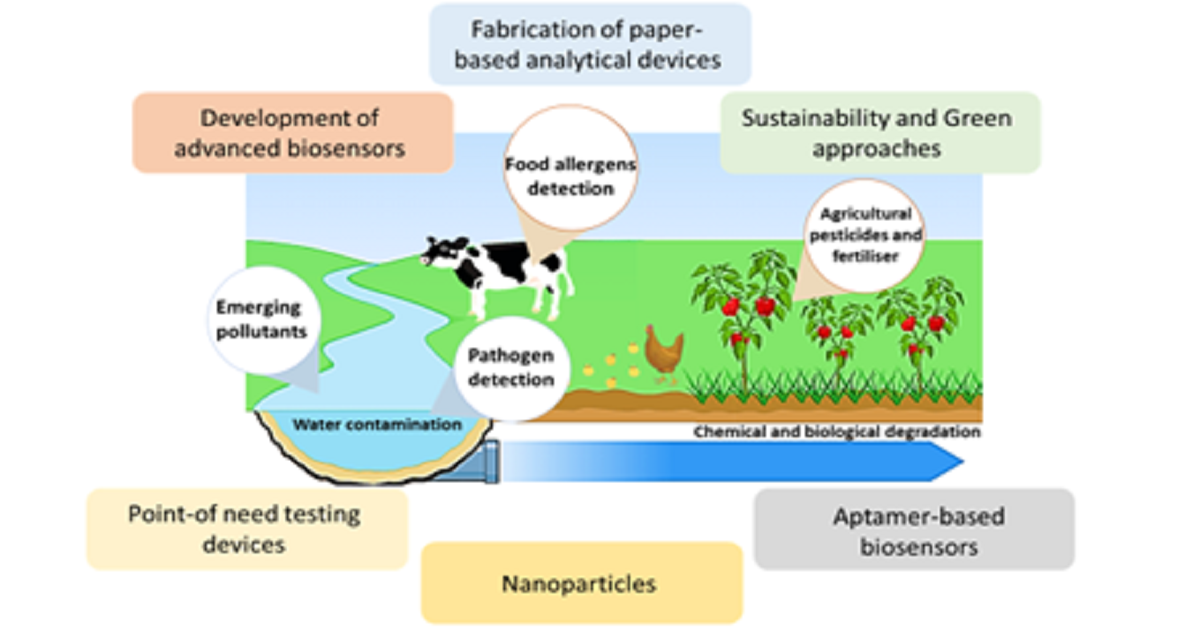Advanced Biosensors for Food Safety and Environmental Applications
A special issue of Applied Sciences (ISSN 2076-3417). This special issue belongs to the section "Chemical and Molecular Sciences".
Deadline for manuscript submissions: 20 November 2025 | Viewed by 310

Special Issue Editor
Interests: food safety and quality control; microfluidic paper-based analytical devices; biosensors; luminescent nanoparticles; optical sensors
Special Issue Information
Dear Colleagues,
Biosensors have emerged as powerful tools for ensuring food quality and safety and monitoring environmental conditions. Mainly, biosensors combine biological sensing elements (aptamers, antibodies, proteins, nucleic acids, etc.) with physicochemical transducers to detect and quantify a wide range of compounds of interest with high specificity and sensitivity. In the realm of food safety, biosensors are utilized to detect pollutants, pathogens, allergens, and toxins, ensuring that food products meet stringent safety standards. They provide low-cost, rapid, and on-site testing capabilities, reducing the reliance on traditional laboratory-based methods that are often time-consuming and expensive. Similarly, in environmental applications, biosensors are employed to monitor pollutants, toxins, and other hazardous substances in water, air, and soil. Their ability to provide real-time data facilitates timely intervention and remediation efforts, thereby protecting public health and the environment.
The Special Issue aims to attract research work addressing the following topics:
- Development of advanced biosensors: innovations in the design and fabrication of biosensors for enhanced sensitivity and specificity and rapid detection in food safety and environmental monitoring.
- Paper-based analytical devices: design and fabrication of innovative paper-based biosensors for cost-effective, portable, and eco-friendly detection of contaminants in food and environmental monitoring.
- Point-of-need testing: advances in portable and user-friendly biosensors for on-site food safety testing and environmental monitoring.
- Nanotechnology: integration of nanomaterials, such as luminescent nanoparticles, with metal–organic frameworks, to improve the performance and functionality of biosensors in food safety and environmental applications.
- Aptamer-based biosensors: development and application of aptamer-based biosensors for improved food safety analyte detection and quantification.
- Interdisciplinary approaches: collaborative research that combines biosensor technology with other scientific fields such as microbiology, chemistry, and environmental science.
- Sustainability and green technologies: development of eco-friendly biosensors and their role in promoting sustainable practices in food production and environmental protection.
- Pathogen and pollutant detection: applications of biosensors for the detection of pathogens, toxins, and chemical contaminants in food products and environmental samples.
- Detection of food allergens: research on biosensor technologies specifically designed for the sensitive and specific detection of allergens in food products to ensure consumer safety.
- Emerging trends: exploration of upcoming trends, future challenges, and potential breakthroughs in the field of biosensors.
This Special Issue on "Advanced Biosensors for Food Safety and Environmental Applications" welcomes submissions that present the latest advances in research on biosensors for food safety and environmental applications. The call is open to a broad thematic range of papers covering the recent applications of novel biosensor technologies, nanotechnology, paper-based analytical devices, aptamer-based biosensors, and research trends aiming at offering readers knowledge for enhancing detection methods, improving biosensor performance, ensuring regulatory compliance, and fostering sustainable practices and innovation in the field.
Dr. Inmaculada Ortiz-Gómez
Guest Editor
Manuscript Submission Information
Manuscripts should be submitted online at www.mdpi.com by registering and logging in to this website. Once you are registered, click here to go to the submission form. Manuscripts can be submitted until the deadline. All submissions that pass pre-check are peer-reviewed. Accepted papers will be published continuously in the journal (as soon as accepted) and will be listed together on the special issue website. Research articles, review articles as well as short communications are invited. For planned papers, a title and short abstract (about 100 words) can be sent to the Editorial Office for announcement on this website.
Submitted manuscripts should not have been published previously, nor be under consideration for publication elsewhere (except conference proceedings papers). All manuscripts are thoroughly refereed through a single-blind peer-review process. A guide for authors and other relevant information for submission of manuscripts is available on the Instructions for Authors page. Applied Sciences is an international peer-reviewed open access semimonthly journal published by MDPI.
Please visit the Instructions for Authors page before submitting a manuscript. The Article Processing Charge (APC) for publication in this open access journal is 2400 CHF (Swiss Francs). Submitted papers should be well formatted and use good English. Authors may use MDPI's English editing service prior to publication or during author revisions.
Keywords
- paper-based analytical devices
- point-of-care testing
- nanoparticles
- aptamers
- metal–organic frameworks and biosensors
- food adulteration
- allergen
- water contamination
- emerging pollutants
Benefits of Publishing in a Special Issue
- Ease of navigation: Grouping papers by topic helps scholars navigate broad scope journals more efficiently.
- Greater discoverability: Special Issues support the reach and impact of scientific research. Articles in Special Issues are more discoverable and cited more frequently.
- Expansion of research network: Special Issues facilitate connections among authors, fostering scientific collaborations.
- External promotion: Articles in Special Issues are often promoted through the journal's social media, increasing their visibility.
- Reprint: MDPI Books provides the opportunity to republish successful Special Issues in book format, both online and in print.
Further information on MDPI's Special Issue policies can be found here.





